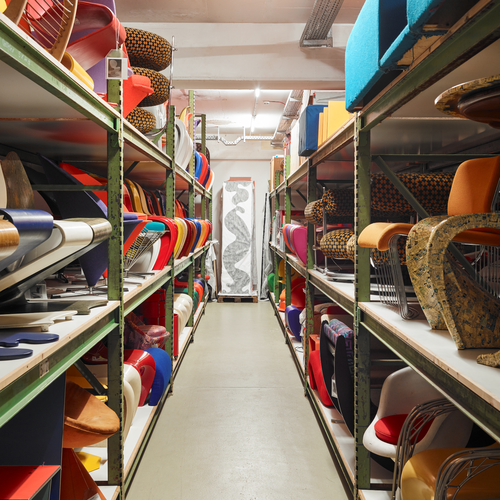The Vitra Design Museum Collection
At the Vitra Schaudepot, which is designed by Herzog & de Meuron, the Vitra Design Museum presents key objects from its extensive collection, creating one the largest permanent exhibitions and research sites on contemporary furniture design. Today the collection of the Vitra Design Museum encompasses a total of around 20 000 objects, with some 7000 pieces of furniture, more than 1000 lighting objects and numerous archives, as well as the estates of such designers as Charles & Ray Eames, Verner Panton and Alexander Girard. Although the main museum building by Frank Gehry (1989) was originally conceived to house the collection, the museum utilises the space to stage major temporary exhibitions. The construction of the Schaudepot allows for a permanent presentation of the collection, while offering a diverse educational programme. The cornerstone for the collection was laid by the museum's founder Rolf Fehlbaum. In the 1980s he assembled a collection of furniture, which he transferred to the Vitra Design Museum upon its founding in 1989. Ever since, the collection has been expanded by the museum's directors (Alexander von Vegesack 1989 – 2010; Mateo Kries and Marc Zehntner 2011 – 2020; Mateo Kries, Sabrina Handler and Heiko Hoffmann since 2020) together with Rolf Fehlbaum and now numbers among the largest of its kind.
The presentation at the Schaudepot is divided into three areas with a total of around 1600 sqm. The ground floor contains the main hall where the extensive permanent exhibition is shown. The central focus is a selection of more than 400 key pieces of modern furniture design from the 1800s until today, including early Bugholz furniture, iconic modernist pieces by Le Corbusier, Alvar Aalto or Gerrit Rietveld, but also more recent examples of 3D-printed objects and lesser-known or anonymous objects, prototypes and experimental models. The permanent exhibition is complemented by smaller, temporary presentations focusing on items of the stored collection. The selection reflects the main areas of emphasis and key pieces of the museum collection while simultaneously providing a comprehensive overview of the history of furniture design - from stylistic and technical innovations to the societal transformations reflected in the objects. Detailed information on the objects is communicated in a digital catalogue that visitors of the Schaudepot can access via their smartphones or guest tablets that can be received from the reception. While the permanent exhibition in the main hall of the Schaudepot is structured chronologically, the glimpses of the other collection holdings on the lower ground level present thematic focal points and offer a view behind the scenes of the museum where conservators and curators deal with objects from the collection on a daily basis. Other aspects of the Schaudepot also serve to make museum work more comprehensible and accessible to the public. From the café, guests can see into the museum offices and the library, which is open to researchers and students on request. The restoration workshop can also be visited as part of our guided campus tours.
With these measures, the Vitra Design Museum raises awareness of the collection and its focus on furniture design and makes it more accessible for visitors and research. At the same time, it reacts towards recent developments that are characteristic for the contemporary design and museum world. Today, design is everywhere - hence a design museum in the 21st century cannot simply collect and exhibit objects, but needs to convey the underlying meaning of the design behind a specific item, by initiating discussions, by revealing societal correlations and by finding connections to architecture, art or technology.



